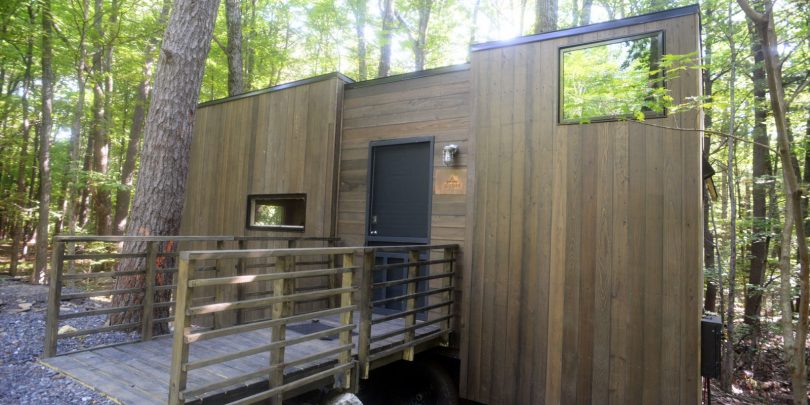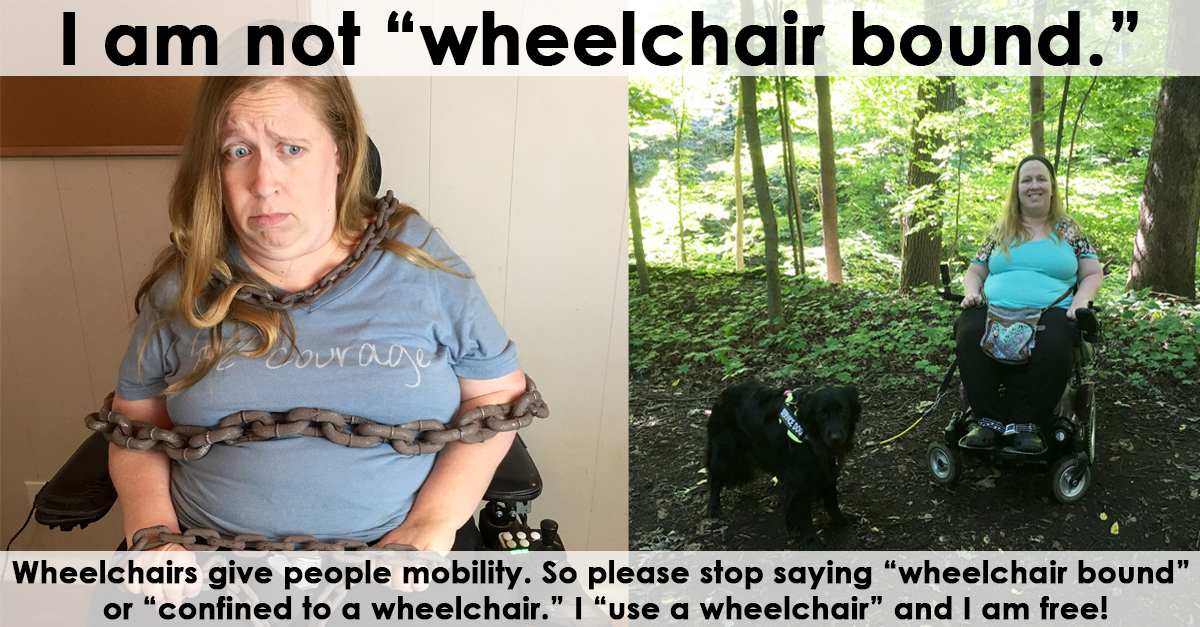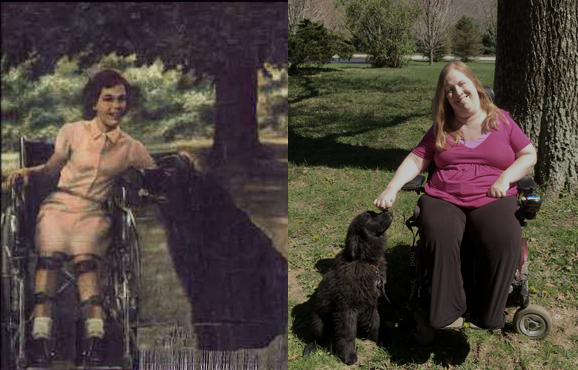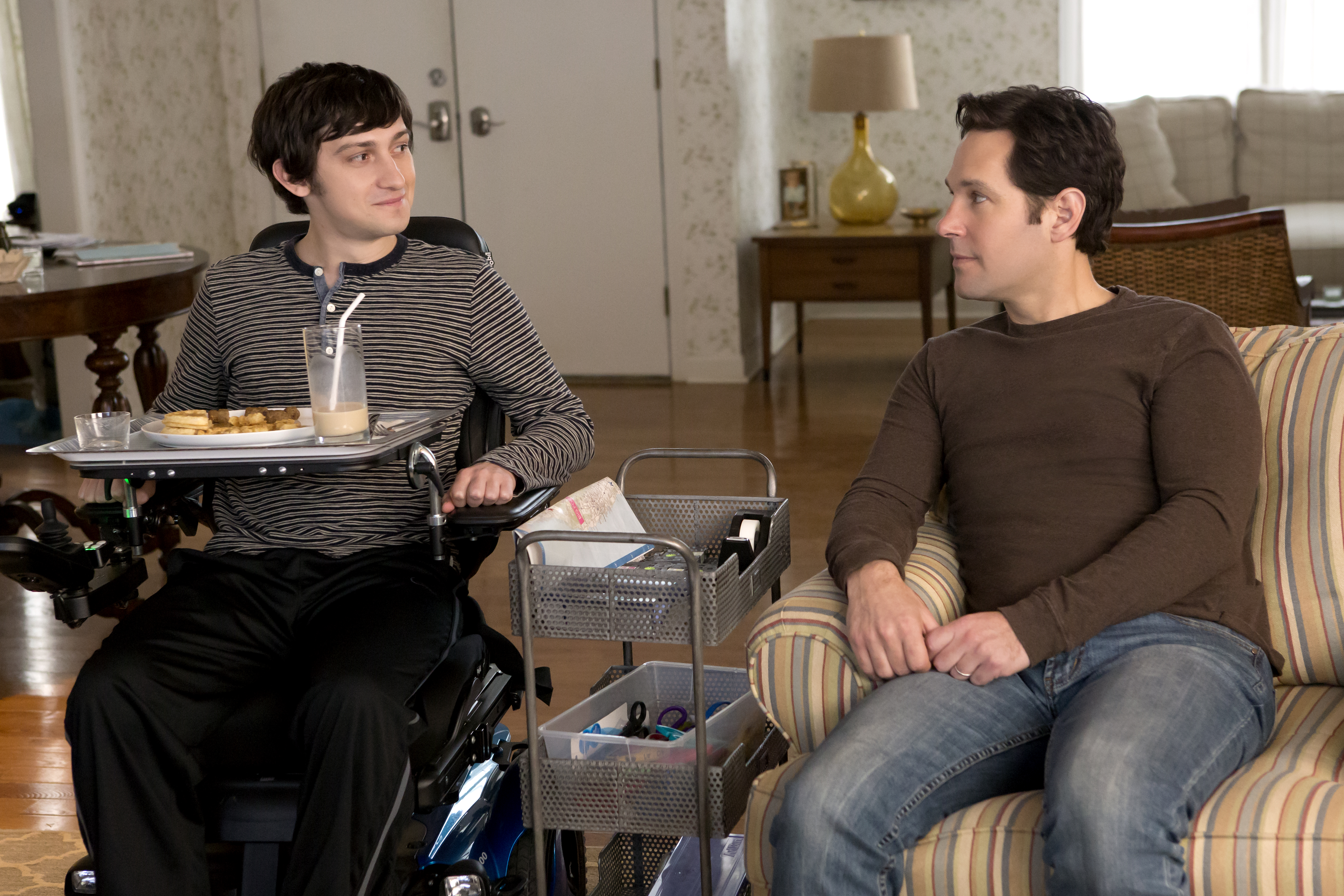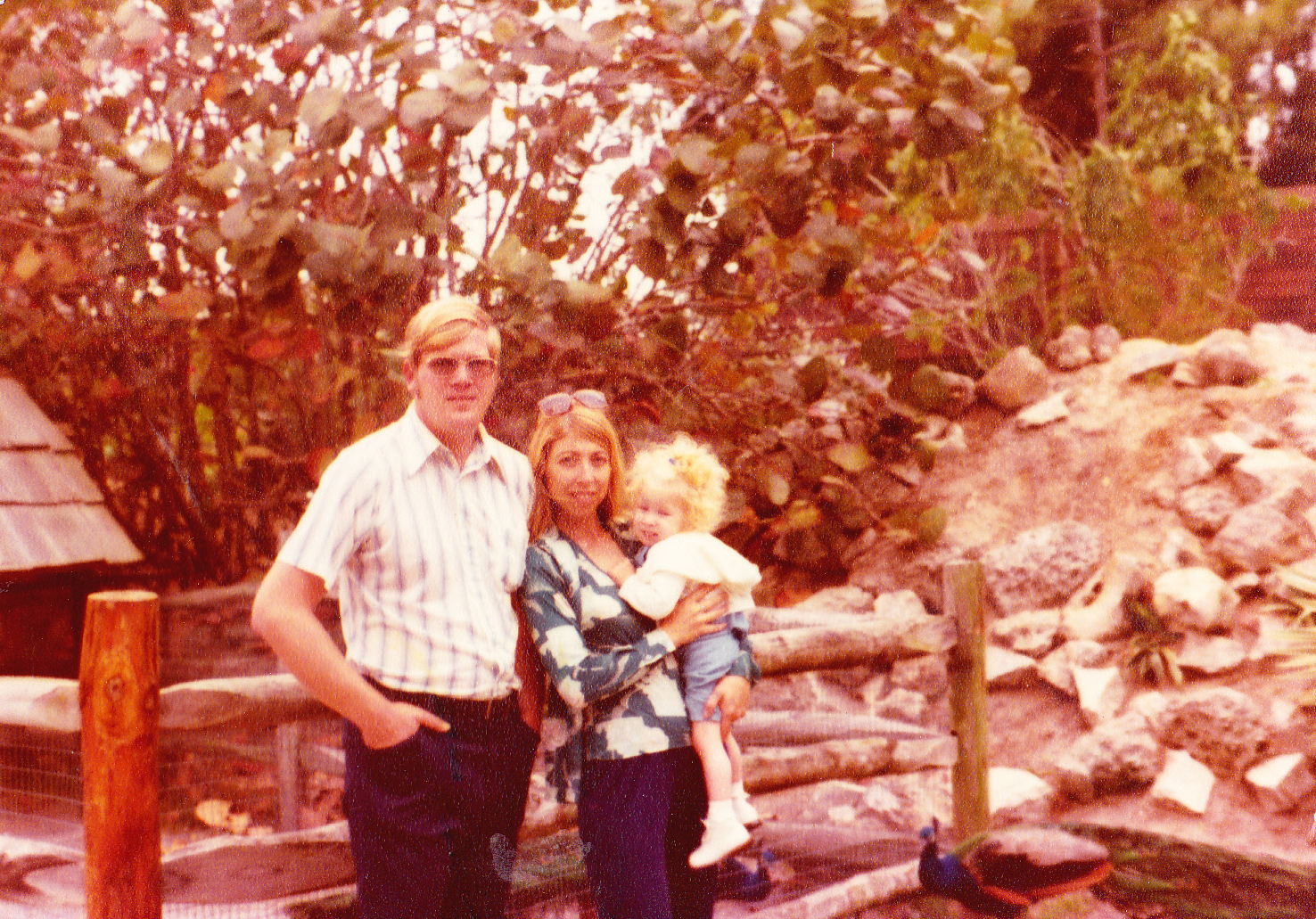Could wheelchair-friendly tiny houses be a “big” option for people with disabilities?
A look at wheelchair accessible tiny houses
If you’ve spent much time on social media, chances are you’ve seen a tiny house pop up in your feed. They’re a growing phenomenon, and for good reason. Tiny houses pack the amenities of a full-size house into a remarkably small footprint, and with considerably more style than the average house on the block. Tiny houses are often built on trailers, and have tons of custom features to suit the personality and needs of their inhabitants. They’re affordable, too; videos abound of people constructing their own tiny houses on wheels for less than $20,000, though most models built by a tiny house company range from $30,000-$80,000.
Although most tiny houses are still built by young couples looking to pursue an environmentally friendly lifestyle, their affordability and customization make them a natural candidate to consider for solving our affordable housing crisis. People with disabilities are particularly harmed by the lack of affordable housing, as the lack of affordable and wheelchair accessible housing is even more scarce. But disability and tiny don’t seem like they go together at all… Or do they?
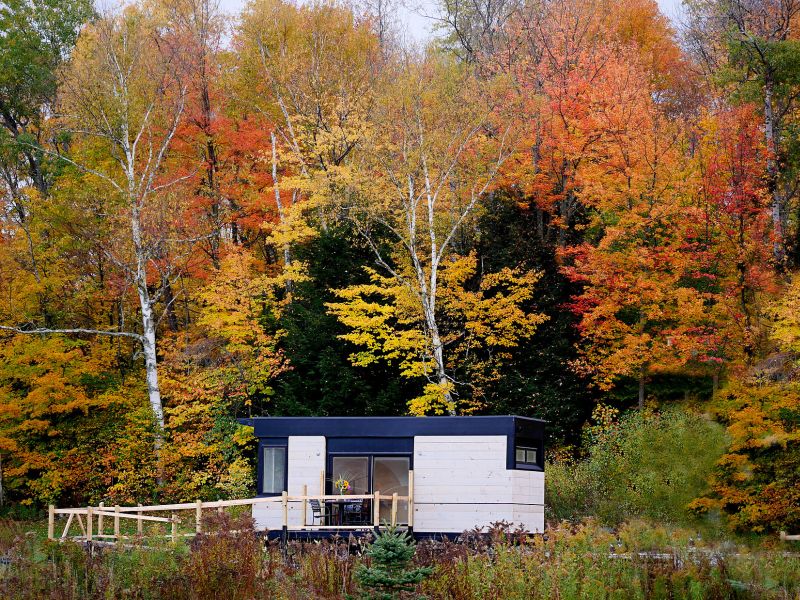
The Wheel Pad wheelchair accessible tiny house.
Tiny Houses for People With Disabilities
When considering the benefits and drawbacks of tiny houses for people with disabilities, we must first look at the overall picture — the full community of people with disabilities. Not all disabilities are physical, and the needs of people with physical disabilities vary considerably. Typical tiny houses can already meet the needs of a significant range of people with disabilities, including many who may struggle with other forms of housing. For example, a person with autism may find it difficult to live in a noisy apartment complex. However, a detached tiny house gives space between neighbors, and can be designed with sound-dampening walls and other features to reduce sensory overload. It can use materials the person finds comforting, such as specific flooring or wall textures, and be themed to the person’s special interests, creating a safe haven in which they can thrive.
Privacy is an important consideration for many people with disabilities. Due to the lack of affordable housing and difficulties in obtaining services such as state funding for in-home care, many people with disabilities live with family members. This can be frustrating to an adult with disabilities who would like to have more independence and freedom to make choices about their environment. A tiny house can be placed in the backyard of the family home, giving a person their own space while still having support nearby to assist with personal care, medication management, and other tasks. If the tiny house is on wheels, it could be relocated if the family moves or if the person is able to live separately on another property.
Tiny houses can also provide outdoor living space that is typically not available to apartment dwellers. There may be room to set up a small garden, helpful to those who wish to eat healthy on a budget and/or have serious food allergies. Many people with a variety of disabilities benefit from a service or emotional support animal; a tiny house with a small yard can provide a safe space for animals and remove the hassle of getting accommodations from a landlord who may not understand the law.
In addition to sensory and mental health conditions, some people with physical disabilities can negotiate the space in a typical tiny house, perhaps with a few modifications. People who are blind or have low vision could benefit from a smaller space that provides easily identifiable paths and tactile guidance via surfaces, handles, etc. People with mild mobility disabilities or whose challenges include fatigue may benefit from a reduced need to walk in the house, and handrails and other supports can be provided for added safety. Instead of putting the bedroom in a loft as is common in tiny houses, it can be on the first floor, with the loft space eliminated or used for storage or a guest room.
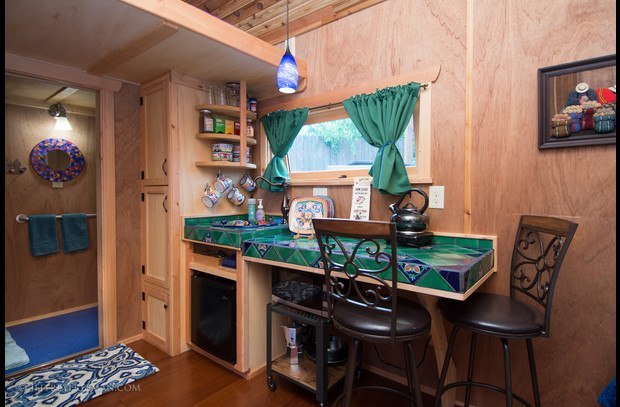
The beautiful Zyl Vardos wheelchair accessible tiny house.
Wheelchair Accessible Tiny Houses
It seems clear that millions of people with disabilities who currently struggle with affordable housing could benefit greatly from tiny living. But what of those of us who use wheelchairs and have little or no ability to walk? Can tiny houses be for us, too?
To examine the factors affecting wheelchair accessibility in tiny houses, we first need to look at the typical dimensions of a tiny house. This is tricky, as there is no official, accepted definition of a tiny house. Some people say under 400 square feet, some under 1000, and so on. We don’t necessarily need to settle on a number, as tiny can mean different things to different people. But intrinsic to a tiny house is keeping it both simple and fully featured, all in a smaller footprint than would be expected for a home with its amenities. So by its nature, a tiny house is small.
While a tiny house built on a foundation can be any dimensions you want, the popular tiny houses on wheels face certain limitations. In general, trailers can be up to 40 feet long, but they must be no more than 8 1/2 feet wide to travel down the road without a permit. That’s where the trouble comes in. The interior width of the home will generally be under 8 feet, and wheelchairs need 32 to 36 inches to get around comfortably without crashing into walls. Wheelchairs also need about a 5 foot space to turn around in; again this varies by model and the skill of the driver, but it’s a good rule of thumb. That leaves only about 2 feet in turnaround spaces to place anything else — a lot of space taken out of a tiny house.
To solve this problem, we can look to the RV industry. They have faced the same limitations, and came up with an innovative solution — the slide out. In case you’re not familiar with them, a slide out is a portion of an RV or camper that expands when the vehicle is parked. They are often used in living room or bedroom areas, but can expand the kitchen or just about any room. In the past, most slide outs had a step up of a few inches, but now level slides with just a small threshold are common. However, level slide outs present a challenge for insulating the floor, which is more necessary for a tiny house than a camper used for vacation or in warm climates. That said, slide outs with a step can still be used in an accessible tiny house to move pieces of furniture that would normally take up a lot of aisle space, such as the sofa, bed, or part of the kitchen.
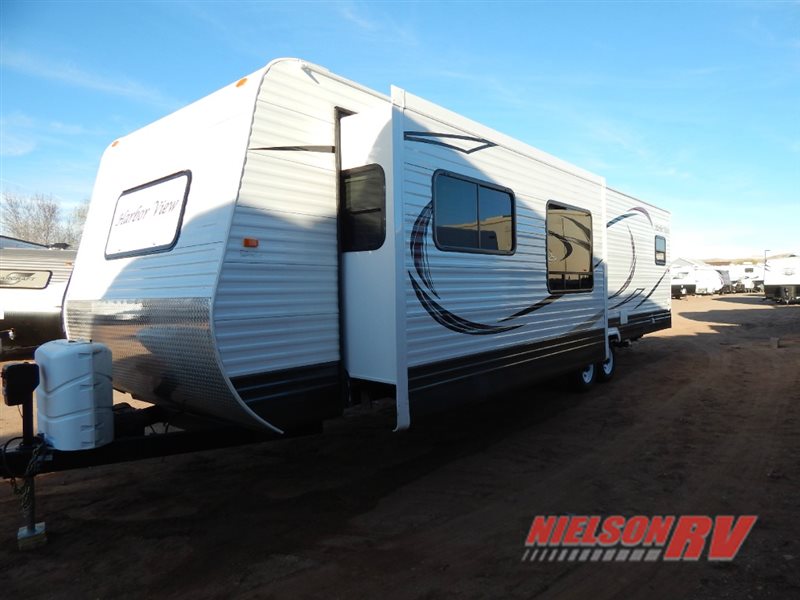
Slide-out on a Harbor View wheelchair accessible travel trailer.
Another challenge of tiny house living for wheelchairs is getting in and out. Most tiny houses sit quite high off the ground. A wheelchair lift could potentially be used, but it presents certain risks, including the possibility of becoming trapped inside or outside the house if the lift breaks down. So instead, many builders have created a lengthy switchback ramp to allow for access. This is fine for a tiny house that won’t be moved often, but trying to transport a massive ramp would be difficult for those who wish to travel. One potential solution is to utilize an ice fishing trailer base. These trailers work similarly to kneeling buses in minivans; they lower to the ground with a touch of a button. This would allow for a much shorter ramp, one that could be folded up against the door for transport or placed inside the house.
People with all kinds of mobility disabilities have very individual needs. Tiny houses are ideal for such situations, as they are custom designed for each person who buys one. Most tiny house builders are willing to listen to their clients and think outside the box. Since everything is being built from scratch, it can be exactly the way a person needs it, but at a cost far less than a full-size custom home.
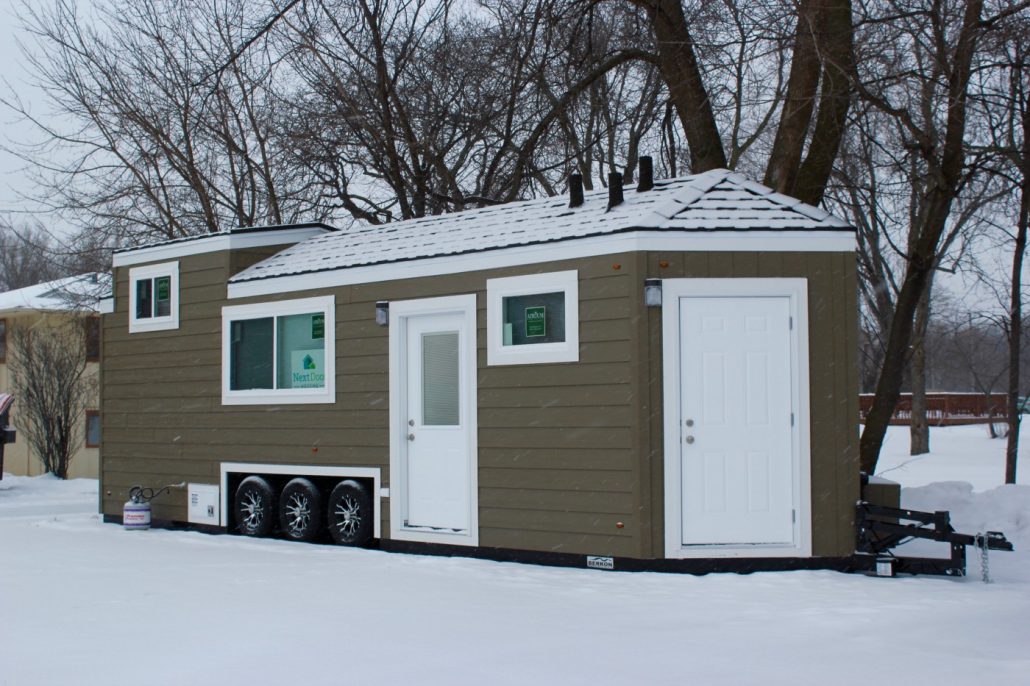
The NextDoor DropHome is built on a hydraulic ice fishing trailer, so it lowers to the ground and only needs a small ramp to be wheelchair accessible.
Moving and Parking Wheelchair Accessible Tiny Houses on Wheels
Many people with and without disabilities who are considering a tiny house on wheels don’t seem to think much about what it takes to move one. Towing any trailer isn’t as simple as hitching it up, and tiny houses present additional towing challenges due to their large size and weight. For people with physical disabilities, it’s even more challenging, as very few vehicles can be both wheelchair accessible and tow a tiny house. There are a couple of companies that make accessible pickup trucks, but they are extremely expensive. Full-size vans are a better option, and 3/4 ton wheelchair accessible vans are fairly common in the new and used vehicle markets. But finding an accessible 1 ton van, which would be required for the largest tiny houses, could be a challenge. Therefore, it might be necessary to hire someone to move your tiny house, which could get expensive if you move often.
If you’re trying to choose between an RV, travel trailer or tiny house, considering weight and ease of towing may help in your decision. If you want to road trip with your home, use it only part-time or plan to stay in warm climates, an RV or a travel trailer may be most convenient. If you want something for full-time living that can last the rest of your life, but still offer the flexibility to move once or twice a year (or every few years), a tiny house on wheels may be the better choice. If you’ve found a permanent location and just want to set up affordable housing on your property or your family’s land, a tiny or larger-but-still-small home on a foundation may be best for practical and legal purposes.
One of the biggest challenges facing people who want to live in tiny houses right now is zoning. Many communities have minimum square footage requirements or limitations on outbuildings. Many neighborhoods will allow you to park a trailer in your yard or driveway, but not actually live in it. Therefore, many tiny house dwellers choose to live in RV parks, rural areas, or in a secluded backyard where they are unlikely to be noticed living in their tiny houses. Things are starting to change, however, and some of those changes specifically benefit people with disabilities by allowing accessory dwelling units (granny flats) for people who need support and care from family. Check the zoning for your area before deciding which type of small living option to pursue, as these rules may permit or favor certain types of dwellings over others.
Whether we choose to live in a tiny house or not, people with disabilities can help advocate for affordable accessible housing by supporting tiny house projects, friendly zoning codes, and variance requests in our communities.
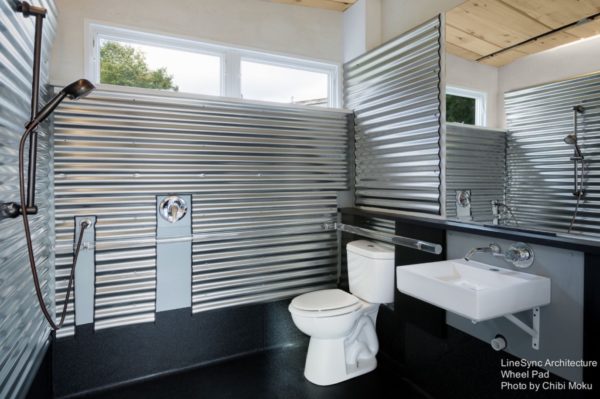
The bathroom in the Wheel Pad wheelchair accessible tiny house doesn’t sacrifice style.
Companies Building Wheelchair Accessible Tiny Houses
Tiny houses offer tremendous potential for people with a variety of disabilities to own a home and increase their independence. So it’s not surprising that a few companies have already built wheelchair accessible tiny houses. Here are a few I found, with my quick thoughts on each:
Zyl Vardos: Abel Zyl is one of my favorite tiny house builders because of the beauty and artistry of his structures. His wheelchair accessible tiny house, available to rent at Caravan, a tiny house hotel in Portland, Oregon, does not compromise on style. It seems to offer some accessibility, with a roll-in shower and rails around the toilet. However, it appears to not have adequate space to park a wheelchair next to the toilet, which would be a major problem for me and many other people with disabilities. It’s also on a 10-foot-wide trailer, so would need a permit every time you want to move it. Still, overall I give the house interior high marks. I can’t say the same for the ramp, however. The Caravan website says they need advance notice to set up the ramp, and it’s not hard to see why. It’s long, metal, and ugly. Since this tiny house stays in the same place, it would be much more attractive with a deck and wooden ramp out front. Abel Zyl says he can build accessible tiny houses and customize to your needs. I’d love to stay in and maybe own a Zyl Vardo someday!
Getaway: If you have only recently heard of tiny houses, chances are it was because of Shark Tank. Getaway Tiny Houses recently appeared on Shark Tank seeking funding for their tiny vacation rentals, but turned down the offers they received. In my opinion, everyone involved missed a great opportunity. Getaway offers a wheelchair accessible tiny house, the Isidore, at their upstate New York location. While the interior isn’t as beautiful as the Zyl Vardo, the home is very accessible and the bathroom appears to be more spacious. In addition, they came up with an attractive, creative solution for the front entrance. Instead of a long, ugly ramp, they parked the home at a lower elevation, then built a lovely wooden bridge across to the higher level. It looks great and integrates the home well with nature. This is a tiny house I would love to spend a weekend in!
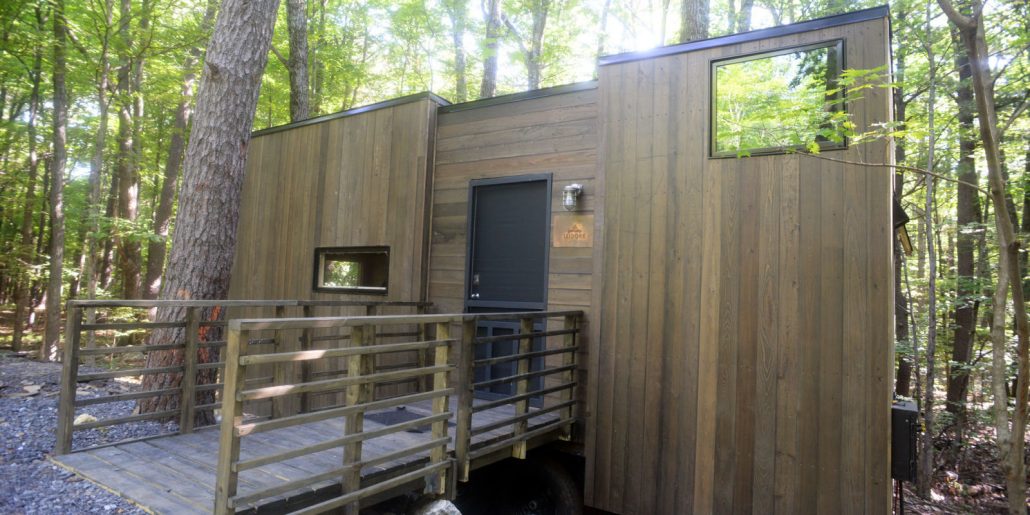
You can book a night at the Gateway Isidore wheelchair accessible tiny house to see if tiny living is for you.
Wheel Pad: This new wheelchair accessible tiny house prototype has been popping up everywhere in the news, and for good reason. It has an upscale modern style and doesn’t compromise on beauty or accessibility. The bathroom is particularly eye-catching, and they wisely made it a wet bath, my design of choice for my own bathrooms as it allows me to shower on the toilet and saves space in the bathroom. Unfortunately, this house also has several major shortcomings, the biggest one being that it completely lacks a kitchen! It’s currently designed to be added onto an existing house to create accessibility for a newly disabled resident, but I don’t see why it couldn’t have a kitchen, as that would allow true independence and flexibility to relocate. At $60,000, it’s very pricey, costing as much or more than other tiny houses that include kitchens and lofts. This seems like the beginning of a great design, if it can be offered with a kitchen and guest loft at a competitive price.
NextDoor Drophome: I have to give this company credit. They thought of using an ice fishing trailer before I did, although I didn’t find them until after I thought of it. They offer both road width tiny houses on wheels and wider park models. Their tiny houses on wheels include kitchens, and for under $50,000. They offer an optional loft, and can customize bathrooms and other areas for your needs. They are currently aimed at the senior care market, but I believe their designs could appeal to a wider range of people with better marketing.
MEDCottage: This company is squarely aimed at the senior care market, and their website and language reflects that. The homes appear to be attractively designed, and the accessibility is great, but the “big brother” and hospital-oriented language of the marketing is off-putting to independently-minded people with disabilities like myself. They currently offer three different plans, and appear to be developing a tiny house on wheels with a large slide out, a great idea. If this company improved their language and marketing, I think they could appeal to a large segment of the disability community.
Ice Castle Fish Houses: Honorable Mention. Ice Castle is not technically a tiny house company, they are a manufacturer of ice fishing travel trailers. However, their designs and customization reflect the tiny house ethos. They may look like traditional campers on the outside, but the interiors of Ice Castle Fish Houses resemble tiny houses, with beautiful wood walls and built-in furniture. They even offer a fish house with a double loft! Since ice fishing trailers are designed to be used in subzero temperatures, they are well-insulated, and their construction quality seems to be far superior to most RVs and campers. The moment I saw them, I recognized the potential for wheelchair accessibility due to the lowering feature, and I was pleased to see that they are now offering accessible models. Only a short ramp is needed when the trailer is in its lowered position. My only concern is that the bathrooms I’ve seen, even in the wheelchair accessible trailer, were not very accessible, with a step either to get in or around the toilet area. But if this can be resolved, Ice Castles seem like a great choice for someone who is looking for something lighter weight than a tiny house but higher quality than a travel trailer. By the way, you don’t have to be into ice fishing… they can make them without the portholes!
Did I miss any wheelchair accessible tiny house companies or models, especially tiny houses on wheels? Please let me know in the comments.
In light of the benefits and challenges, are tiny houses a good idea for people with disabilities? Of course, there is no right or wrong answer. It depends on the needs and circumstances of each individual. I wrote this guide to help with my own decision-making process, but I wanted to share the options I’ve discovered and also reach out to the tiny house community for more information and support.
Why I Considered “Going Tiny”
My own interest in tiny houses began a few years ago when I was searching for prefab wheelchair accessible bathrooms that could be added onto a home. I was thinking of moving, but I had been through the hassle of renovating multiple times, and wondered if there was a fast solution for accessibility. I then started wondering whether I could buy a mobile home and just move it if I ever wanted to move again… and in the process of researching that, I discovered tiny houses.
As a frequent traveler with a disability, I have longed to be able to take wheelchair accessibility with me wherever I go. I purchased a used RV about 10 years ago, but for various reasons, it didn’t work out and I sold it at a considerable loss. But I knew that with the right setup, it would have been great for me — and a couple years later, I regretted having sold it, even with its problems. In 2014, I was the victim of a home invasion robbery and had to move suddenly for safety reasons. A big factor in deciding where to go was being able to stay with a relative who had an accessible home, but it was in a place where I didn’t want to live. I was lucky to have that person and that place, but I ended up staying in the area, only to realize that, as I suspected, it really isn’t for me.
My choices were limited by my need for accessibility, and I want to change that. I don’t want to get stuck where I am. I need more flexibility to move wherever life takes me, and that led me to look at wheelchair accessible tiny houses.
“Going tiny” would present a number of challenges for me, many of them unrelated to my disability. Yes, I need extra space for my wheelchair, but I also have four big dogs. I care about the environment and hate McMansions, but my main goal is to design a home that’s portable, rather than simple. I’m far from a minimalist; I’m something of a clothes horse, and I have a few collections I’m quite attached to including musical theatre memorabilia and tiki mugs. I also have a couple of must-have items that absolutely won’t fit in a tiny house, the most important one being a spare wheelchair.
How the Pandemic Changed My View on Tiny Houses
As I write this update, it is 2021 and the world seems to finally be emerging from the nightmare of the coronavirus pandemic. As a person at high risk of serious complications or death from the virus, I spent the last year almost entirely confined to my home and neighborhood. I did not go to a single indoor public place, except for medical appointments, during that time. Thankfully, I was able to get vaccinated very quickly after vaccines became available, and I am now slowly venturing out into the world again.
Many times over the past year, I thought about what it would be like to spend the pandemic in a tiny house. I realized very quickly that I would’ve lost my mind. I struggled significantly with my mental health while living in a 1400 square foot house; I can’t imagine how terrible it would have been to be stuck in only 400 square feet or less.
I still believe that small, efficient homes are one of the best affordable housing options for people with disabilities. However, there is a big difference in livability between tiny and small. We can learn a lot from the tiny house movement, but we also need spaces that are not going to be cramped and potentially damaging to our mental health. So I’m now focusing my interests and advocacy on prefab cabins, park model mobile homes, modular homes and similar small but reasonable options that have tremendous untapped potential for the disability community.
Wheelchair Accessible RVs and Campers — Pandemic-Safe Travel
While I no longer want to live in a wheelchair accessible tiny house, the pandemic has made me a stronger advocate for accessible outdoor activities, including camping. Camping is one of the few safe travel options for people with disabilities when a dangerous virus is spreading indoors, but even beyond that, the disability community would benefit so much from more opportunities to connect with nature. Yet there are very few wheelchair accessible RVs and campers available, and those that exist are extremely expensive and/or still provide limited accessibility in the bathroom, kitchen, and other key locations.
I am currently seeking to collaborate with companies to develop housing and camping options that will empower people with disabilities to live our lives to the fullest. If you are interested in hiring me as a consultant, please email me.
Updates
I will always maintain this page so people with disabilities can find wheelchair accessible tiny houses and related housing options. Tiny house folks, please comment or email me with your thoughts and any information I missed!

